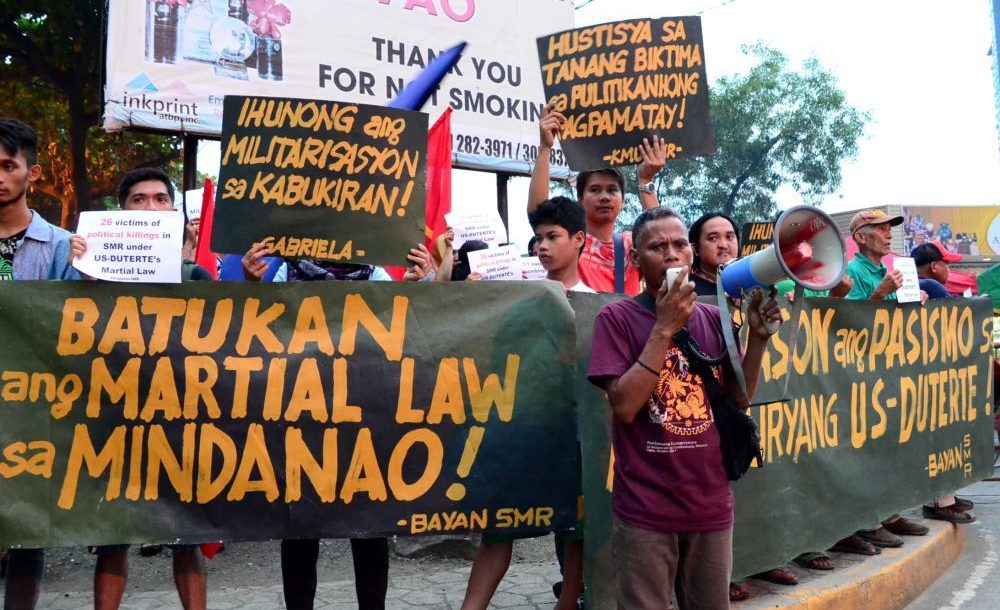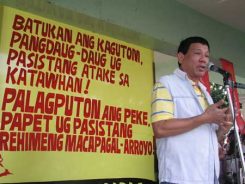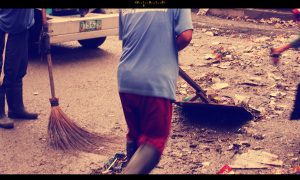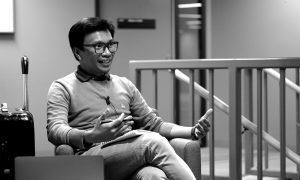Editor’s note: this is the third in a series of posts we’re bringing you this week that feature the views of young writers from President Rodrigo Duterte’s home region of Mindanao on two years of Dutertismo. Previously, lawyer Abdel Jamal Disangcopan reflected on what it means to witness Duterte’s presidency from the perspective of a Mindanaoan who previously admired aspects of Duterte’s local leadership, and Jade Mark Capiñanes wrote about “How not to make fun of Rodrigo Duterte”.
The Cagayan de Oro City commute was an invitation to the unfamiliar. We cut our way short. We passed through Dominorog in Talakag, Bukidnon and its dusty, unpaved road with almost no people idling by. On a huge tarpaulin was a command: “Support federalism and martial law in Mindanao.” The words were printed in yellow against black.
It was forging solidarity and obedience. It was a battle cry against Imperial Manila, and the other for peace and security—at least in the point of view of Mr Rodrigo Duterte’s crusaders.
Out here in Mindanao, a Duterte emblem—a clenched fist adorned with the Philippine flag—has been rendered indelible. It is in every town and city and on wrist ballers and bumper stickers. Count the life-sized cardboard standees of the president too. They rest in hotels, bus stations, and party shops.
In the first quarter of 2018, Duterte was rated excellent in Mindanao—an 89% full trust. The magnitude of support dichotomises us. Non-Mindanaoans accuse Mindanaoans of blindness. Mindanaoans accuse non-Mindanaoans of naïveté. But the simplistic view of Mindanao as a Duterte-loving island baffles me. Homogenising us underestimates our ability to acknowledge nuances of narratives.
“Is there a space of dissent in Mindanao?” I asked young activists in General Santos, Davao Region, and Marawi City.
I took this opportunity to make sense of the President’s popularity, and to put perspectives of what was missing in the grand narrative of Duterte’s rise to power. After all, 11% of those who do not trust him have a story to tell too.
The activists maintained they never folded their banners. We just weren’t paying attention.
Against busaw
I met Anne (not her real name) one Monday morning along with other members of a youth group in General Santos City. They welcomed me in their office and served vegetable dishes they bought at an eatery nearby.
Anne spoke of activism and political issues eloquently. She was the class valedictorian in a Lumad school in Compostela Valley, Davao Region. Formed by community workers, a Lumad school provides alternative education to indigenous peoples tailored to their needs, such as agriculture and human rights education, among others.
She is among the first batch of the senior high school graduates in the country.
On the 2017 State of the Nation Address, President Rodrigo Duterte threatened to bomb lumad schools. He claimed the schools were illegal and operated by New Peoples’ Army—the armed wing of the Communist Party of the Philippines which was classified as a terrorist organisation by the president himself.
After this speech, the children in the community started to ask, why would a highest official stop us from getting access to education by brutal means? They wished the president would lift martial law and would stop harassing them through his mouth.
The young activists I talked to are immersed in rural Mindanao. They are aware of the convulsive and unreported conflicts in the area. Their version of a heightened military encampment is an oppressive mechanism of the government, enabling risks of human rights violations. With military camps placed near schools, the kids would recall Filipino folklore by referring to men in green and brown as busaw—a corpse-eating ghoul at night, an ordinary person at day.
This name-calling against the military, which is fulfilling a peacekeeping operation, in born of a long history of affliction even before Duterte’s leadership: red tagging, trumped-up murder charges to imprison a suspected rebel, intimidation, harassment, displacement, and most of all, killings.
When a Duterte ran for President, the Lumads recognised the name. The elders endorsed his candidacy. The voters walked several hours at the nearest precinct to write his name in the ballot. After all, he was the Davao City mayor who had not wavered in his advocacy: ensure the welfare of the indigenous peoples confronted with “wars of extinction.”
Carol, one of my interviewees, was too young to vote when election came. Had she been older that time, she would undoubtedly vote for Duterte. She cannot forget his sincerity when he personally talked to the Lumad communities, assuring them they will reclaim what is rightly theirs.
But Carol and Anne shall never forget the case of Obello Bay-ao, a Manobo youth of Salugpongan Ta’Tang Igkanugon Community Learning Center in Talaingod, Davao del Norte. Two alleged paramilitary men shot him in broad daylight on 5 September 2017, barely a week after he joined Lakbayan, a protest camp in Manila to call for an end to the militarisation and martial law in Mindanao. He was 19 years old.
It was not hard for the activists to connect Bay-ao’s death to another incident in Lianga, Surigao del Sur. Thousands of Manobos ran away from their community after a military occupation took its toll on July 6, 2017. This displacement was alarming as the people concerned were the same ones who fled to evacuation centres after the paramilitaries killed three community leaders—Dionel Campos, Aurelio Sinzo, and Emerito Samarca—on 1 September 2015.
Some Lumads wanted to show dissent against impunity and penury. The kids would ask Carol and Anne if there are still more demonstrations in the city. Even if their demands may fall on deaf ears and lead to dangers of tagging them as terrorists, it did not matter to them. The young activists wanted to put their narratives at the forefront.
Anne would give them a more convenient option, and that is to go to school.
Much is to be learned in her alma mater, Community Technical College of Southeastern Mindanao Inc. It taught them to value the importance of criticising social conditions and empower the agriculture sector with teachers who obliterated their feudal control over the student’s mind. For instance, learning about political issues would become more meaningful and empowering to Anne as her teachers allowed students to lead the discussions through their own experiences without any restraint.
As a Lumad school is geared toward a nationalistic, mass-oriented, and scientific approach to education, the Lumad youth are not to be duped. They have estranged themselves from the systematic violence they had long suffered.
They never wished it would be bombed.
The president’s pronouncement on destroying Lumad schools enraged people in the hinterlands. But with rage comes hope as they maintain a space that resists anti-poor and pro-military policies to grant themselves the fundamental rights to life, education, and self-determination.
Against miseducation
Rejection and apathy are blocks that try to subdue the young activists in urban Mindanao. But they are focused on a more important duty, and that is to call upon the people to come out from their comfort zone through dialogues and mobilisations.
Over the phone, I talked to Miriam—a twenty-four-year-old community organiser. She was lobbying to the administrators of the Department of Education in South Cotabato province to grant Lumad schools permits to operate. The task was important to Miriam, because SOCCSKSARGEN Region, according to a report, has the most number of closed schools in Mindanao.
She said there are 33 Lumad schools forcibly closed due to militarisation. Such encampments had targeted not only students, but also teachers and Parent-Teacher Community Association officers. She said how lucky can students in urban schools be; they need not risk their lives to earn an education.
The urban youth’s inaction and social apathy toward the present administration are a matter of privilege. This is a kind of privilege that grants them to evade grave repercussions, especially on their own safety. Besides, the youth are awfully tired of politics, an insight Richard confirmed.
When I interviewed Richard in Mindanao State University’s Peace Plaza hours before their commemoration and gathering in remembering the Marawi Siege, he lamented on how they—college students expected to be empowered by a university diploma—refuse to move. He understood though that in the eyes of some people, dissent automatically equates to radicalisation.
Miriam added that the lack of emphasis on critical thinking from educational institutions in Mindanao deprives students of civic participation, an initiative that should have allowed them to be uncomfortable and sentient.
There is danger of being framed an enemy of the state, or heated disagreements from people—teachers, pastors, friends, and even parents—who defend the president. These student activists have their anecdotes of surveillance and public shaming too. Miriam, for example, was among those who bore online tirades and threats after staging a rally in a university to condemn the tax reform law she deemed anti-people. She also recalled one of her colleagues, Randy, who was closely watched by armed assets when he was still in school.
They had toughened up. Miriam started as a student activist since 2011, and Richard had deferred graduation for a two-year development work in rural Mindanao.
Perhaps what keeps the miseducation in some urban areas is social media. Note that people from rural areas can hardly receive the daily news, which saves them from the hodgepodge of truth claims and influence by social media users’ tweaked stand.
Here in urban areas, the influencers are their new political science teachers, affirming the youth’s unexamined views. Educators do not correct misinformation. It’s not on their course syllabus.
In developing an environment open to critical scrutiny, they actively engage people online or offline. Miriam learned that not antagonising Duterte supporters is key, as she sees that their approval of Duterte carries a story that must not be overlooked. If it takes an emotional attachment to cling to a populist, it will also take the same for people to expand their consciousness of the harsh conditions that may escape their peripheral vision.
Duterte’s selective human rights record
The first in our series of perspectives from young writers from Mindanao on two years of Dutertismo.
Popularity precedes policies. This trajectory has been widely observed, looking at how this regime maintained public support amid several crackdowns. In Mindanao, it is hard to predict if the Duterte emblem will soon fade or outlive us. As of now, what bothers me is when necessary narratives escape us because we select our sympathies, or we lacked the grit to expose them.
Mindanao’s perception about Duterte depends mainly on each lived experiences and struggles. While no view is more important than the other, it is important to recognise that stories are complex, and stories are what we need. The young progressives in Mindanao and their show of dissent are worthy of respect. But they should not be the only ones who strive to give each critical voice an equal footing.
 Facebook
Facebook  Twitter
Twitter  Soundcloud
Soundcloud  Youtube
Youtube  Rss
Rss 



